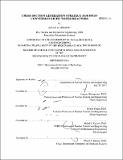Cross section generation strategy for high conversion light water reactors
Author(s)
Herman, Bryan R. (Bryan Robert)
DownloadFull printable version (23.00Mb)
Alternative title
Cross section generation strategy for HCLWR
Other Contributors
Massachusetts Institute of Technology. Dept. of Nuclear Science and Engineering.
Advisor
Eugene Shwageraus and Benoit Forget.
Terms of use
Metadata
Show full item recordAbstract
High conversion water reactors (HCWR), such as the Resource-renewable Boiling Water Reactor (RBWR), are being designed with axial heterogeneity of alternating fissile and blanket zones to achieve a conversion ratio of greater than one and assure negative void coefficient of reactivity. This study assesses the generation of few-group macroscopic cross sections for neutron diffusion theory analyses of this type of reactor, in order to enable three-dimensional transient simulations. The goal is to minimize the number of energy groups in these simulations to reduce computational effort. A two-dimensional cross section generation methodology using the Monte Carlo code Serpent, similar to the traditional deterministic homogenization methodology, was used to analyze a single RBWR assembly. Results from two energy group and twelve energy group diffusion analyses showed an error in multiplication factor over 1000 pcm with errors in reaction rates between 10 and 60%. Therefore, the traditional approach is not sufficiently accurate. Instead, a three-dimensional homogenization methodology using Serpent was developed to account for neighboring zones in the homogenization process. A Python wrapper, SerpentXS, was developed to perform branch case calculations with Serpent to parametrize few-group parameters as a function of reactor operating conditions and to create a database for interpolation with the nodal diffusion theory code, PARCS. Diffusion analyses using this methodology also showed an error in multiplication factor over 1000 pcm. The three-dimensional homogenization capability in Serpent allowed for the introduction of axial discontinuity factors in the diffusion theory analysis, needed to preserve Monte Carlo reaction rates and global multiplication factor. A one-dimensional finite-difference multigroup diffusion theory code, developed in MATLAB, was written to investigate the use of axial discontinuity factors for a single RBWR assembly. The application of discontinuity factors on either side of each axial interface preserved multiplication factor and reaction rate estimates between transport theory and diffusion theory analyses to within statistical uncertainty. Use of this three-dimensional assembly homogenization approach in generating few-group macroscopic cross sections and axial discontinuity factors as a function of operating conditions will help further research in transient diffusion theory simulations of axially heterogeneous reactors.
Description
Thesis (S.M.)--Massachusetts Institute of Technology, Dept. of Nuclear Science and Engineering, 2011. Cataloged from PDF version of thesis. Includes bibliographical references (p. 146-149).
Date issued
2011Department
Massachusetts Institute of Technology. Department of Nuclear Science and EngineeringPublisher
Massachusetts Institute of Technology
Keywords
Nuclear Science and Engineering.